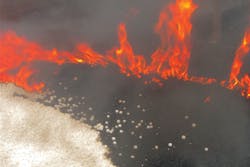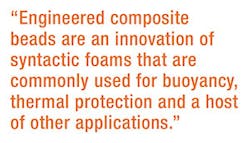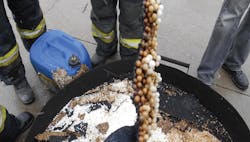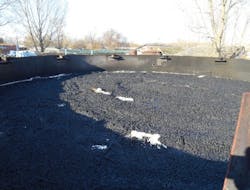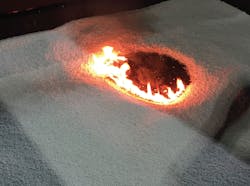Storing flammable liquids, particularly crude oil, with high vapor pressure poses difficult challenges for fire protection and fire safety. While existing codes for fire foam may be effective under the best conditions, they are largely ineffective in extremely cold conditions in which water is either scarce or frozen. This can pose extraordinary problems when active, water-based fire protection systems fail to perform. The problem is compounded in cold climates where temperatures of -40°F are common.
Engineered composite beads were developed to address the need for a non-water based fire protection solution for flammable liquids, particularly high vapor pressure crude oil. While initially developed for cold climates, the technology offers unique benefits that can be applied in virtually all climates and with different hydrocarbons, including liquefied petroleum gas (LPG) and liquefied natural gas (LNG), for mitigating a vapor cloud scenario using a relatively simple and passive method. The technology also shows potential to change the paradigm of how to deal with flammable liquid storage tank fires.
Background & testing
Engineered composite beads are an innovation of syntactic foams that are commonly used for buoyancy, thermal protection and a host of other applications. The syntactic foams discussed in this article are called composite beads. They are defined as being comprised of hollow spheres combined with a resin. Once cured, this combination produces a useful shape that is stable, rigid and lightweight.
The resulting composite bead tolerates continuous, long-term exposure to hydrocarbons of many sorts including toluene, crude oils, diesel, ethanol, acetone and gasoline. In addition, when beads are exposed to high temperatures, such as those that occur during a fire, they will intumesce, creating a thermal barrier, protecting the underlying beads. The beads exposed to fire expand and interlock with adjacent beads creating a crust that forms a tighter vapor barrier.
Passive fire prevention testing conclusions
To prove the effectiveness of engineered beads in fire protection, multiple tests were conducted in several labs and large-scale test sites across four years. The tests demonstrated passive vapor suppression on both polar (ethanol) and non-polar fuels. The potential applications include floating roofs for tanks, sumps, horizontal tanks and barges.
Large oil storage tanks are frequently equipped with rim-seal fire protection but not full-surface fire protection. The beads can offer a passive solution to a full-surface fire scenario when applied alone on the liquid or on top of an existing internal floating roof.
If placed on an existing internal floating roof, beads would remain in place. In the event of a sunken floating roof, from a seismic event or weld failure, they would simply remain on top of the liquid providing an effective vapor suppressing barrier and replacing the role of the sunken roof. This is valuable in high-risk situations or when tanks are near high-value assets and when maximum protection from a full-surface fire is required.
If the primary reason for tank spacing is to reduce the heat transfer to an adjacent tank in the event of a full-surface fire, then the distance between storage tanks may be reviewed with a possible outcome of reduced tank spacing. The beads also offer advantages when compared to traditional internal floating roofs because they lack legs, pontoons or secondary seals that typically decrease the useful height of a tank by as much as nine feet. Moreover since the beads easily float on non-flashing hydrocarbons, the potential exists that the 11.1 psi vapor pressure limit for traditional floating roofs set by the U.S. Environmental Protection Agency would not be applicable.
Potential new method for fighting oil storage tank fires
The beads’ ability to tolerate continuous exposure to hydrocarbons suggests that they could be used in an entirely new way, potentially changing the paradigm of how tank fires without a floating roof are fought. Currently if an oil storage tank has a full-surface fire, the traditional response is to drain the contents as quickly as possible while resources are mounted to provide adjacent tank cooling and possibly to introduce a firefighting agent such as aqueous film-forming foam (AFFF). However, draining may take many hours, and mounting a manned response carries inherent risks, particularly near the tank or tanks.
Successful application of AFFF to a full-surface oil fire can be challenging even in the best conditions. In addition, introducing sufficient AFFF to a tank fire may be difficult, depending on wind speed and direction, water pressure, equipment, and proximity to the tank.
Engineered beads create a potential new method of fighting tank fires. Using existing pumps, piping and infrastructure, the new method would deliver the beads directly to a target tank fire without deploying firefighting personnel to the tank or tanks. An existing oil manifold pipe can be used. Probably the largest pipe in the facility, these manifold pipe systems are usually powered by large pumps that are many miles away at an upstream pump station or using gravity. Likewise, the oil dispatchers who operate the tank manifold valves operate them frequently, so they have virtually no learning curve for how to operate the system or special emergency procedures that can be confusing during a fire.
In the new paradigm, the oil dispatchers would isolate all tanks except the target tank with the fire and route oil flow into the target tank. Two large isolation valves connected at the manifold would then be opened, diverting flow through a large-diameter pipe pre-filled with beads and causing the oil flow to carry beads directly to the target tank. In this way, all the fire suppressant beads would be delivered directly to the target tank by the largest pumps with the highest flow rate and through the largest diameter piping.
Once inside the tank, the beads float rapidly to the surface and spread, creating the vapor or fire-suppressing blanket. The oil protects the beads from extreme heat during their subsurface deployment as they rise to the surface. Newly arriving beads would be added from beneath the oil surface lifting the top layer of beads into the fire and causing them to intumesce and thereby protect the underlying beads. In this way, the maximum amount of fire suppressant could be delivered exactly to the target tank quickly and efficiently without personnel going near the fire.
The method was tried with some success during a conceptual phase test. Issues encountered were because of the small diameter and tight radius of the piping that was available. This plugged prematurely, limiting the number of beads injected. Further work is necessary to test and refine the method. However, it demonstrates great promise, particularly if a facility’s piping can be designed to deliver beads effectively to tanks.
LNG vapor suppression
The beads’ effectiveness at vapor suppressing high-vapor pressure products prompted the LASTFIRE team, a leading international forum related to developing best practice guidance on all aspects of storage tank fire hazard management, to propose its application on cryogenic flammable liquids including LNG, comprised of methane, and LPG, comprised of propane and butane. The hypothesis was that the beads’ thermal insulation properties might reduce the boil-off rate.
For LNG and LPG, one problem occurs when a vapor cloud resulting from a large LNG or LPG release ignites, causing potential accidents to nearby people and storage facilities. Some applications require possible large releases to be directed to remote pits or sumps in which the LNG can boil off safely. Remote pits have inherent risks because of placement and flashing because they can freely flow a long distance based on wind speed and direction.
A test was designed to determine if the beads could be placed in a pit or sump in advance of any spill and to measure their ability to vapor suppress LNG. In addition, the test measured the radiant heat from the residual boil-off vapors once ignited. The data could be used to determine safe distances for personnel and facilities, with the goal of understanding if a prefilled sump with beads could be placed closer to the potential spill area or bulk storage, reducing the vapor cloud by passive means.
LNG/LPG testing conclusions
Testing by LASTFIRE demonstrated the engineered beads’ ability to effectively suppress vapors from flashing LNG and LPG, mitigating the risk of a vapor cloud scenario. Moreover if the residual vapors were to ignite, the heat would be significantly reduced. The tests demonstrated the potential for sumps prefilled with beads and located near storage or transfer locations to mitigate a vapor cloud scenario. A key lesson learned involved the importance of removing any free water from the pit or sump.
Conclusions
Engineered composite beads were developed and tested to effectively vapor suppress common hydrocarbon fuels for short- and long-term vapor suppression. Moreover, they demonstrated that they were effective on polar and non-polar fuels. Their application as a floating bed of beads on non-flashing hydrocarbon liquids provides passive protection from full-surface fires or as passive vapor suppression for sunken roof scenarios. Applied on top of an existing internal floating roof, they offer a simple and passive solution to prevent full-surface fires. Eliminating the potential for a full-surface fire challenges conventional tank-spacing rationale and could result in tighter, more efficient tank spacing. Other applications include sumps, horizontal vessels and barges.
Limited testing demonstrates the beads’ potential to delay boil overs when applied in depths less than needed to completely extinguish the fire. The beads reduced the heat intensity, and the boil over delay could improve the outcome of the event.
Active fire suppression was demonstrated with incipient fires allowing for rapid extinguishing. When tests involved a long pre-burn of fuel, the beads operated synergistically with AFFF firefighting foam that protects the beads during deployment and at the tank walls. Fire tests on ethanol demonstrated the ability of the beads to protect AFFF from dissolution and, acting in combination, to control and extinguish the fire. Active fire suppression is an area that requires further research and development.
Because of the beads’ ability to tolerate constant, long-term contact with different hydrocarbons, they allow the possibility of a new method of fighting oil-storage tank fires where they might be applied using existing pumps and piping infrastructure. The method would avoid traditional firefighting methods that require specialized equipment and the deployment of personnel to the affected storage tank. Further research and development is necessary, although the method appears promising.
Finally, testing on cryogenic liquids like LNG and LPG demonstrates the beads’ ability to passively provide vapor suppression. An example application is a sump prefilled with beads near bulk storage vessels that mitigates a vapor cloud scenario in the event of a spill. If the diminished boil off vapors were to ignite, the beads could significantly reduce thermal radiation and the threat to nearby persons, bulk storage vessels or facilities.
Robert Kelly is general manager of Trelleborg Applied Technologies in charge of global customer solutions and new material development. He may be reached at [email protected].
